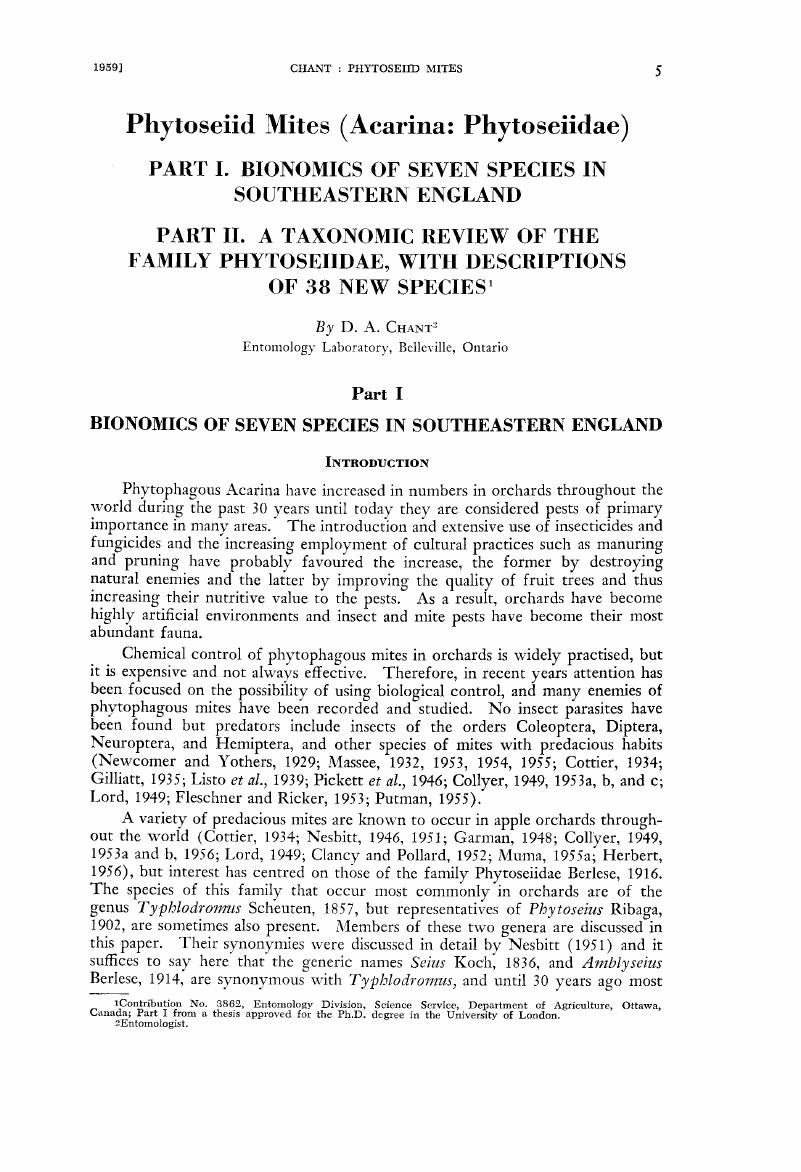Crossref Citations
This article has been cited by the following publications. This list is generated based on data provided by Crossref.
DOSSE, GUDO
1961.
ÜBER DIE BEDEUTUNG DER POLLENNAHRUNG FÜR TYPHLODROMUS (T) PYRI SCHEUTEN (=TILIAE OUD.) (ACARI, PHYTOSEIIDAE).
Entomologia Experimentalis et Applicata,
Vol. 4,
Issue. 3,
p.
191.
Post, A.
1962.
Effect of cultural measures on the population density of the fruit tree red spider mite,Metatetranychus ulmi Koch (Acari, Tetranychidae).
Tijdschrift Over Plantenziekten,
Vol. 68,
Issue. 1,
p.
1.
Vrie, M.
1964.
The distribution of phytophagous and predacious mites on leaves and shoots of apple trees.
Entomophaga,
Vol. 9,
Issue. 3,
p.
233.
Karg, Wolfgang
1965.
Larvalsystematische und phylogenetische Untersuchung.
Mitteilungen aus dem Museum für Naturkunde in Berlin. Zoologisches Museum und Institut für Spezielle Zoologie (Berlin),
Vol. 41,
Issue. 2,
p.
193.
Karg, Wolfgang
1965.
Larvalsystematische und phylogenetische Untersuchung.
Mitteilungen aus dem Museum für Naturkunde in Berlin. Zoologisches Museum und Institut für Spezielle Zoologie 〈Berlin〉,
Vol. 41,
Issue. 2,
p.
193.
ZAHER, M. A.
WAFA, A. K.
and
SHEHATA, K. K.
1969.
LIFE HISTORY OF THE PREDATORY MITE PHYTOSEIUS PLUMIFER AND THE EFFECT OF NUTRITION ON ITS BIOLOGY (ACARINA: PHYTOSEIIDAE).
Entomologia Experimentalis et Applicata,
Vol. 12,
Issue. 4,
p.
383.
Ward, Lena K.
1969.
A survey of the Arthropod fauna of plum trees at East Malling in 1966.
Bulletin of Entomological Research,
Vol. 58,
Issue. 3,
p.
581.
Rack, Gisela
1969.
Massenvorkommen vonNeoseiulus barkeri HUGHES, 1948 (Acarina, Phytoseiidae) und sechs weiterer Milbenarten in einem Neubau.
Anzeiger für Schädlingskunde und Pflanzenschutz,
Vol. 42,
Issue. 12,
p.
184.
Flaherty, D. L.
and
Huffaker, C. B.
1970.
Biological control of Pacific mites and Willamette mites in San Joaquin Valley vineyards: I. Role ofMetaseiulus occidentalis.
Hilgardia,
Vol. 40,
Issue. 10,
p.
267.
Swirski, E.
Amitai, S.
and
Dorzia, N.
1970.
Laboratory studies on the feeding habits, post-embryonic survival and oviposition of the predaceous mitesAmblyseius chilenensis Dosse andAmblyseius hibisci Chant [Acarina: Phytoseiidae on various kinds of food substances.
Entomophaga,
Vol. 15,
Issue. 1,
p.
93.
Flaherty, D. L.
and
Huffaker, C. B.
1970.
Biological control of Pacific mites and Willamette mites in San Joaquin Valley vineyards: II. Influence of dispersion pattern ofMetaseiulus occidentalis.
Hilgardia,
Vol. 40,
Issue. 10,
p.
309.
Karg, Wolfgang
1970.
Neue Arten der Raubmilbenfamilie Phytoseiidae Berlese, 1916. (Acarina, Parasitiformes).
Deutsche Entomologische Zeitschrift (neue Folge),
Vol. 17,
Issue. 4-5,
p.
289.
Kropczynska-Linkiewicz, D.
1973.
Proceedings of the 3rd International Congress of Acarology.
p.
225.
Ma, Wei-Lan
and
Laing, J. E.
1973.
Biology, potential for increase and prey consumption ofAmblyseius chilenensis (Dosse) [Acarina: Phytoseiidae).
Entomophaga,
Vol. 18,
Issue. 1,
p.
47.
Delattre, P.
1974.
Étude de l'efficacité prédatrice deZetzellia mali [Acarina, Stigmaeidae] vis-a-vis du Tétranyque du Pommier,Panonychus ulmi [Acarina, Tetranychidae].
Entomophaga,
Vol. 19,
Issue. 1,
p.
13.
Ivancich-Gambaro, Paola
1975.
Observations on the biology and behaviour of the predaceous miteTyphlodromus italicus [Acarina: Phytoseiidae] in peach orchards.
Entomophaga,
Vol. 20,
Issue. 2,
p.
171.
Swirski, E.
and
Ragusa, S.
1976.
Notes on predacious mites of greece, with a description of five new species (mesostigmata: phytoseiidae).
Phytoparasitica,
Vol. 4,
Issue. 2,
p.
101.
Croft, B. A.
1976.
Establishing insecticide-resistant phytoseiid mite predators in deciduous tree fruit orchards.
Entomophaga,
Vol. 21,
Issue. 4,
p.
383.
McMurtry, J. A.
1977.
Some predaceous mites [Phytoseiidae] on citrus in the mediterranean region.
Entomophaga,
Vol. 22,
Issue. 1,
p.
19.
Swirski, E.
and
Ragusa, S.
1977.
Some predacious mites of Greece, with a description of one new species (Mesostigmata: Phytoseiidae).
Phytoparasitica,
Vol. 5,
Issue. 2,
p.
75.



